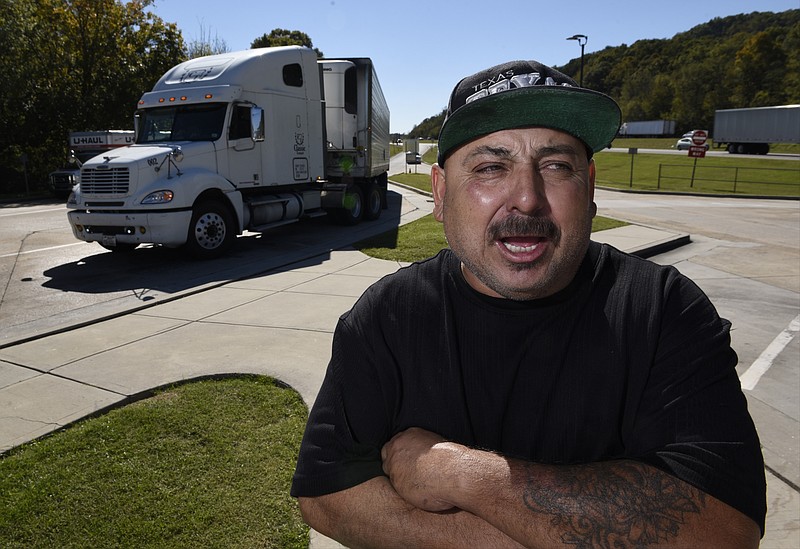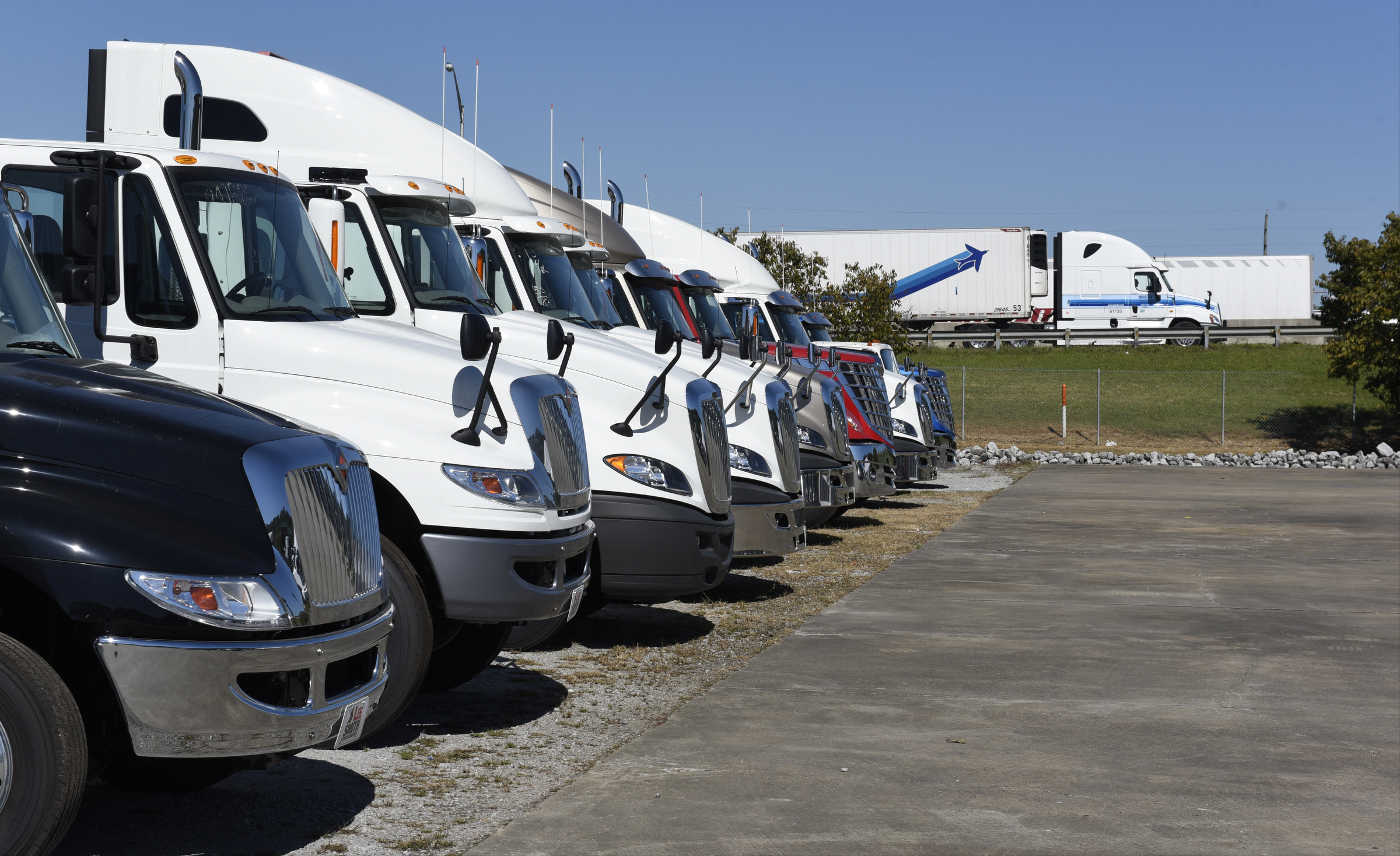More Info
* Nearly 48,000 more truck drivers are needed today to fill current demand* $73,000 is median annual wage for a trucker that works for a private fleet*45 percent of new drivers needed to replace retirees* 3 million heavy-duty Class 8 trucks moved 9.2 billion tons of freight last year.* Trucks consumed more than 37 billion gallons of diesel fuel to move that freight.* Freight tonnage hauled by trucks will increase 28.6 percent by 2026 and trucking will remain the dominant mode of transportation with 64.6 percent of all freight moved by trucks a decade from now.* Truck freight revenues will grew 74.5 percent to $1.152 trillionSource: American Trucking Association
Around 3 p.m. on a sunny late October afternoon, Robert Perez pulled his tractor-trailer - and his haul of 44,000 limes - up to the curb at the Lookout Valley rest area and welcome center near the Tennessee-Georgia line.
Perez runs a dedicated route, always carrying limes from his hometown of McCallen, Texas - a city of 130,000 right on the U.S.-Mexico border - to the northeastern states, the driver's nightmare region with its tangled, crowded roads and low bridges.
But Perez is glad to do it.
Driving makes him a good living. Trucking provided a stable, 20-year career after he lost his previous career as a machinist at a Texas cotton gin. And after 20 years of long-haul driving, Perez has worked up to a hearty $85,000-a-year salary, working less than 12 months a year.
But all good things must eventually come to an end. Perez is in his 60s, and says retirement is on the horizon.
"I'm about to just leave it alone and go fishing and be with my grandkids," he said. "Twenty years will be good enough for me as a truck driver."
The scenario presents a major problem for motor carriers.
Nationwide, experienced drivers like Perez are calling it quits, and nobody is waiting to fill their shoes when they do. The average age of truck drivers today is 49.
The result is a dire, national shortage of truck drivers. By the end of this year, the American Trucking Association predicts there will be a shortage of 48,000 drivers.
The shortage first showed itself in 2005, when the ATA estimated the industry was short 20,000 drivers. During the recession, freight movement slowed as consumers stopped spending and the shortage waned.
Coming out of the downturn, the problem re-emerged, and worse than before. There were already fewer drivers to move freight, and the rise of competing industries like construction drew workers away from trucking.
Going forward, the ATA estimates trucking companies will need to hire a collective 89,000 drivers a year to keep up with demand - which is good news for the country's more than 3 million existing truck drivers, as well as anyone looking to get into a career in trucking.
Anxious to recruit new drivers and keep the ones they have, trucking companies over the last few years have been forced to repeatedly raise salaries, improve benefit packages, promise more home time and update their tractor fleets.
As a result, the annual average pay for truck drivers in America right now is $73,000.
And still, it doesn't seem to be enough.
Going forward, with the demand for freight movement projected to increase steadily over the next decade, the country's trucker shortage is projected to increase to 174,000 by 2024.
****
In an online help-wanted posting, The Rosedale Group - a Dalton, Ga.-based transportation and warehousing provider - makes its case to those looking for a work driving a big truck: be home weekends and a couple of times during the week, make 42-cents-per-mile base pay with some experience and get a $2,000 sign-on bonus within the first year at the company.
Sara Duffy, recruiting manager at Rosedale, knows her audience.
"If you're aiming for a certain caliber of drivers, you have to pay accordingly," she said. "They can pretty much pick and choose where they want to go."
The Rosedale Group is looking for drivers who are at least 23 years old, preferably with some experience. But even straight-out-of-driving-school candidates are welcome to apply, though they'll be put through a six-week Rosedale training program.
When Duffy started at Rosedale, the company was offering its drivers around 28 cents a mile. Now, Rosedale is offering its new drivers, just out of school and training, 43 cents a mile.
And most Rosedale drivers travel 2,800 to 3,200 miles a week, carrying freight they never touch, load or unload.
At 43 cents-a-mile, a driver getting 2,800 miles a week for 52 weeks will make almost $63,000. A driver making the same amount but driving 3,200 miles a week for 52 weeks will make almost $77,000.
And there's opportunity to make more. Rosedale just increased driver wages twice in the last year and looks to do it again this spring.
"You can write your own ticket," said Duffy.
****
Ever-climbing driver wages don't come without some sort of trade-off for motor carriers, who are tasked with making regular pay increases while keeping profits strong.
Ultimately, it's the consumers who eat the costs. The increases in trucker pay have forced the carriers to charge their customers (manufacturers, retailers) higher shipping rates. And those customers, to offset the increase in their transportation costs, wind up charging customers more for their products.
Rick McNabb, vice president at Rosedale, hopes the chain reaction isn't confused for greed on the motor carriers' part.
When the recession hit, "people were in survival mode," he said.
But now, "in the past year, and this year currently, we're starting to see it trend the other way, but the only way we can get it to trend is to hire these drivers, which we've had to go back to our customers and get rate increases and things along that nature," said McNabb.
"And companies aren't being greedy, I'll say trucking companies aren't being greedy, to the point they're asking for the rate increases," he said. "They're asking to be able to pay these drivers what they're due."
McNabb sees the astronomical turnover rate among motor carriers as the first obstacle to overcome.
Turnover rates at for-hire motor carriers (which carry freight for other companies) in 2014 were more than 90 percent, according to the ATA, meaning a carrier with 100 drivers had to replace more than 90 of them in a year's time, due to drivers largely either retiring or going to work for another trucking company.
Turnover is higher within larger fleets.
At Rosedale, officials have agreed to offer more money to help offset the problem. But they also totally overhauled Rosedale's business model to make it possible to get drivers more home time, a key, they believe, to keeping people happy.
Also, Rosedale makes personal interaction a priority, that drivers are called by their names and not their truck numbers. Right now, the company's annual driver turnover rate is 71 percent.
"The pay increases have helped significantly, they really have," said McNabb.
But still, he believes there's more to do.
"At the end of the day, we've made the driving job a lot more difficult, but the drivers haven't been compensated anymore," he said. "Now, they can demand that, and they're getting that."
Contact staff writer Alex Green at agreen@timesfreepress.com or 423-757-6480.

